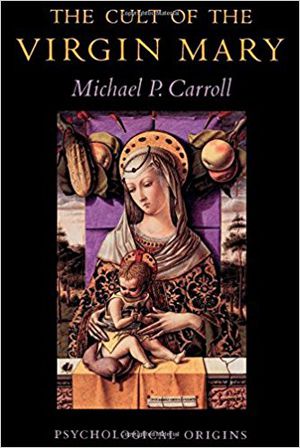Cult of the Virgin Mary by Michael Carroll

The Cult of the Virgin Mary by Michael Carroll investigates the historical, sociological, and psychological origins of Marian devotion. He argues that Marian devotion is a unique phenomenon because it is based on the adulation of an asexual mother, that it has explicit historical origins in fifth-century Rome, and it is more common in certain geographical regions than others due to specific ecological and psychological factors. Carroll defines Marian devotion as an immensely popular cult that is often neglected by scholars, even those seeking to explain the division between Catholics and Protestants or explore the sociology of cults like Scientology. In order to uncover the origins of such a powerful popular movement, Carroll investigates the aspects of Marian devotion that make it exceptional in history, and claims that this process will lead to a more complete understanding of early Christianity and the greater human experience.
Carroll contextualizes his approach within both historical and psychological treatments of Marian devotion. The work of historian Guy Swanson connected Marian devotion to agricultural societies with certain political systems, while the structuralist approach of Edmund Leach revealed links between an emphasis on the intercessory role of Mary and patronage, a social organization that concentrates the power in the hands of a few inaccessible rulers. Carroll also uses Carl Jung’s[32] theories of a mother archetype that exists within the human unconscious and manifests itself as goddess worship and Marian devotion. For the purposes of this paper, Carroll’s analysis provides a useful foil for Blackbourn’s cultural approach to the apparitions at Marpingen and Sperber’s social approach to nineteenth-century German Catholicism because it focuses on origins of Marian devotion that are completely independent of nineteenth-century German experiences. Carroll builds his book around three fundamental questions: why is Mary both a virgin and a mother when other goddess cults celebrate the obvious connection between sexuality and maternity; why does Marian devotion develop in the fifth century, at the same time as the crucifixion symbolism; and why does Marian devotion originally take hold most strongly in Spain and Southern Italy? Carroll answers each question in turn, using a combination of historical interpretation and Freudian psychoanalysis.
Freudian analysis is the primary tool in Carroll’s kit as he constructs answers to his first and third questions. The devotion to a manifestation of a sexless mother derives from an unconscious need to disguise children’s infantile desires for incestuous relationships with their parents. According to Carroll’s analysis, a child’s sexual desire for the parent of the opposite gender is more common in families that have female authority figures due to the father’s need to be away, seeking sustenance. This “father ineffective family” was a common feature of life in Spain and Southern Italy, due to a combination of harsh ecological and social factors.
Carroll then seeks the fifth-century origins of Marian devotion within the context of the “great transformation” of Christianity “from a middle-class movement to one that incorporated people from all levels of Roman Society.” [34] Carroll argues that Marian devotion was the result of a calculated and successful attempt to integrate peasants into the Christian religion by allowing popular goddess devotion to be transformed into Marian devotion. Carroll also argues that the masochism associated with repressed sexual desires can be seen in the disassociation of Mary with all elements of sexuality, and is also reflected by the fifth-century focus on the crucifixion and the torture of Christ, as well as the celebration of celibacy, or “symbolic castration.” These devotional developments within early Christendom are set against the growing material inequity in fifth-century Rome.
Carroll then tests his theories by applying them to several Marian apparitions. Having established the theories that Marian devotion originates most often in marginalized agricultural communities in need of an sympathetic intercessor, and in ‘father-ineffective-families’ that display both Freudian desires and material needs, Carroll seeks to prove them with evidence from Lourdes, Pontmain, Fatima, and other apparition sites. While his theoretical analysis had been fascinating, if generalized, the weakness of Carroll’s argument is exposed in this empirical section of his book. He spends many pages distinguishing between illusions and hallucinations and defining visionaries as either primary or secondary, while neither distinction proves particularly insightful. Once he finishes categorizing the visionaries and their visions, Carroll seeks the origins of their experiences. Many deceased people have been academically resurrected and psychoanalyzed, and Carroll attempts to do just that to several of the visionaries. The basic premise of applying Freudian techniques to historical questions is problematic. How can a historian simultaneously provide a voice to long-dead individuals and then apply psychoanalysis to the individual the historian himself has constructed?
Ultimately contributing the observation that the French visionaries of the nineteenth century were most likely “prompted by unconscious infantile memories” that were activated by recent events, Carroll’s analysis does not actually augment the reader’s understanding of either the personal or historical origins of the visionaries’ dramatic experiences. However, Carroll does establish the importance of apparitions in Marian devotion, the role of imitation in apparition stories and the interaction between popular religion and social upheaval through his comparison of a variety of Marian apparitions. Unfortunately he relies almost exclusively on Freudian theory for his analysis, and the reader is reminded that once a historical argument becomes defined by the belief in a theory that all humans are shaped by the repression of their sexual desires for their parent, then that theory loses all usefulness as an analytical tool.